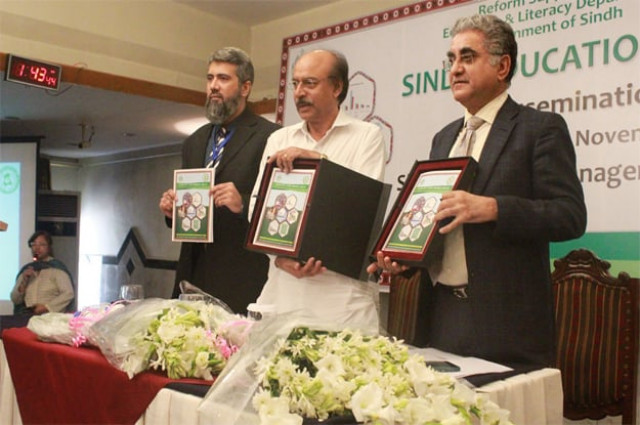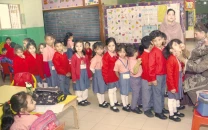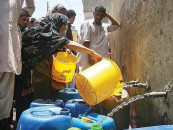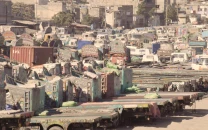Primary schools are the limit
Education dept launches report revealing 90% of Sindh’s schools are primary level

Education dept launches report revealing 90% of Sindh’s schools are primary level. PHOTO: NNI
There are very few options left for students after they complete primary education in Sindh’s public schools as 90 per cent of the 46,039 schools in the province are primary level.
This was shared by the chief programme manager of Sindh education department’s Reform Support Unit (RSU), Faisal Ahmed Uqaili, during the 24th Sindh Education Profile 2014-2015 of the Sindh Education Management Information System (Semis). The report was launched by the Semis team on Wednesday.
Bhagsar: a model public school
Uqaili shared that only four per cent of all public schools in Sindh are middle schools. This is alarming and is the reason why we have a large number of dropout students, he added.
The data shared by the Semis team was collected through an annual school census that aims to hold the education department accountable for its yearly performance. The RSU has made the findings a public document to make the most of the data and statistics gathered by the team.
Representing the department, education secretary Fazlullah Pechuho told The Express Tribune how their department lacks even basic data as the exact number of public schools in Sindh. There are 39,000 schools registered with the biometric system but there is still a gap of about 4,000 schools that are not registered with the Sindh government, he said. “The schools that are not registered are mostly non-viable schools because many primary schools were built in Pervez Musharraf’s era,” he explained.

According to him, the census gives the department an idea about where to grant funds. He explained how the report focuses on water, toilet and electricity facilities in schools and even gives a broader view of how much funds a school needs for infrastructure and maintenance.
Divisions: How schools get their funding
Sharing one of the slides in his presentation, he said that out of 4.1 million enrolled students, 68,615 students are those who do not have Semis registration codes. “The report is based on the data collected until October, 2014,” he said. He added that the department has taken a number of steps since then and they hope that next year’s report will show better results.
The report also showed that there is gender disparity in the provision of educational facilities. There are 10,614 boys’ schools and only 7,058 girls’ schools, along with 28,367 co-education schools in Sindh. But in terms of enrolment, around 2.5 million boys are enrolled among the 4.1 million students enrolled in the province.
As he launched the report, education minister Nisar Ahmed Khuhro appreciated the efforts made by the team. “This team works the entire year, gathers information and conducts surveys for more than seven months, after which, it takes four months to compile, check data, layouts and print it,” he said, explaining how the team has been working each year for the last 24 years.
Upgrades: ‘Expenditure on education is vital’
“If I know that [a certain] number of schools do not have a teacher, only then can I appoint a teacher,” he said, explaining how the findings of this report help them formulate the right policies.
Solving problems: How the data can help improve the state of education
Education experts in Sindh hope the collection of authentic data is the first step towards change. “We have to dig out and resolve where the problem is,” said educationist Baela Raza Jamil. “We have data that shows the actual figures.” She added that what is now needed is only a policy to make things work. Meanwhile, Salman Naveed Khan from Alif Ailaan appreciated the effort of making the data publicly available for further references. He added, however, that this data should be updated as there is almost a gap of one year of information. “Statistics are changing every minute,” he said. “If the government needs to make it more usable, they have to make it timelier.”
Accountability: Why make the data public?
Annual School Census is collecting this data and gathering information about school profiles, enrolment and staff information for the last 24 years but now this data should be disseminated for people to provide a better overview of the system. This demand was made by the chief programme manager of Sindh education department’s Reform Support Unit, Faisal Ahmed Uqaili.
Work on database of students at public schools set to begin
There are three reasons to make this data and report public. One is to make it available for the stakeholders and let them know the ground reality of the education system in Sindh. Secondly, to make it available for people to get references and use the data for further researches and surveys. The third reason is to facilitate the donors with the yearly progress of the education sector in the province.
Uqaili also mentioned during his presentation that Semis data is collected and evaluated for monitoring purposes, to maintain education quality and teachers recruitment.
Published in The Express Tribune, November 12th, 2015.



















COMMENTS
Comments are moderated and generally will be posted if they are on-topic and not abusive.
For more information, please see our Comments FAQ